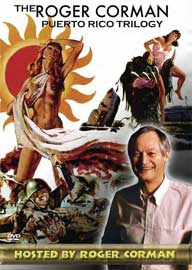 THE
ROGER CORMAN PUERTO RICO TRILOGY: THE LAST WOMAN ON EARTH (1960), CREATURE
FROM THE HAUNTED SEA (1960), BATTLE OF BLOOD ISLAND (1960)
THE
ROGER CORMAN PUERTO RICO TRILOGY: THE LAST WOMAN ON EARTH (1960), CREATURE
FROM THE HAUNTED SEA (1960), BATTLE OF BLOOD ISLAND (1960)“King
of the Drive-Ins,” “King of the Bs,” or “King of the
Independents”; whatever you might want to refer to him as, Roger Corman
is one of the most important and influential individuals to be mentioned on
this website. During his days of producing and directing one film after the
next, one small chapter of his career took Corman and his tiny entourage to
beautiful Puerto Rico to shoot two films back to back in a matter of weeks.
But this is Roger Corman we’re talking about, so three films actually
resulted from this little vacation: THE LAST WOMAN ON EARTH and THE CREATURE
FROM THE HAUNTED SEA, both directed by Corman, and BATTLE ON BLOOD ISLAND, directed
by Joel M. Rapp. All of Corman’s efforts done for his Filmgroup company
have gone into the public domain with original film elements lost, so these
three titles have been previously available through various budget DVD outfits.
Retromedia has now released them with better transfers than before (especially
in the case of LAST WOMAN) in a highly recommended box set loaded with extras.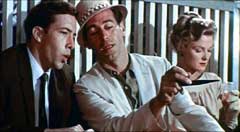
The principal feature in this collection is THE LAST WOMAN ON EARTH, presented by itself on the A side of the disc. Racketeer Harold Gern (Antony Carbone), his sultry wife Evelyn (Betsy Jones-Moreland) and their lawyer Martin Joyce (Edward Wain) are enjoying a vacation in sunny Puerto Rico. After scuba diving in the middle of the ocean, they come aboard their boat to find its driver dead, surmising that something has permeated the oxygen, causing the deaths of what appears to be every living thing. With dead bodies lying all over a motionless city, they eventually take shelter in a spacious house and carry on with their lives. Considerable tension sets in as Martin sets sights on Harold’s wife, and she seems anything but disinterested in his attentions. Fighting for survival might be their prime objective, but the ultimate fight proves to be attaining the “last woman on earth.”
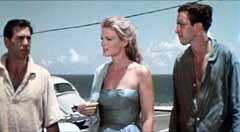 The
most well-known aspect of THE LAST WOMAN ON EARTH is the involvement of a very
young Robert Towne, the noted screenwriter who would go on to CHINATOWN, THE
LAST DETAIL and many others. Towne was working on the script for Corman, but
didn’t complete it in time, ending him up on location to play the third
lead (as to not have to pay another actor), and completing it on the set. Hence
Towne used the acting pseudonym “Edward Wain” and would also appear
in THE CREATURE FROM THE HAUNTED SEA. LAST WOMAN tends to be uninspired and
somewhat dull, but the dialogue rises above it, as do the fine performances
of the three leads, allowing the film to be absorbing as a post-apocalyptic
drama where the laws of morality no longer applies. Assuming that a nuclear
menace caused the narrative’s mass devastation, very little sci-fi attributes
are present, and a mood of eeriness is briefly offered when the trio of survivors
stroll down an alley of corpses, including that of a young girl.
The
most well-known aspect of THE LAST WOMAN ON EARTH is the involvement of a very
young Robert Towne, the noted screenwriter who would go on to CHINATOWN, THE
LAST DETAIL and many others. Towne was working on the script for Corman, but
didn’t complete it in time, ending him up on location to play the third
lead (as to not have to pay another actor), and completing it on the set. Hence
Towne used the acting pseudonym “Edward Wain” and would also appear
in THE CREATURE FROM THE HAUNTED SEA. LAST WOMAN tends to be uninspired and
somewhat dull, but the dialogue rises above it, as do the fine performances
of the three leads, allowing the film to be absorbing as a post-apocalyptic
drama where the laws of morality no longer applies. Assuming that a nuclear
menace caused the narrative’s mass devastation, very little sci-fi attributes
are present, and a mood of eeriness is briefly offered when the trio of survivors
stroll down an alley of corpses, including that of a young girl. 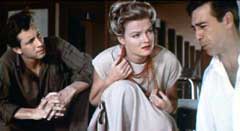
Always riddled with extremely poor video presentations in the past, Retromedia has located a rare 35mm print element for this transfer. Presented in its original 1.85:1 aspect ratio (non anamorphic), the image is extremely pleasing, enough so to make all previous video presentations trash can worthy. The print is remarkably blemish free, with only some wear at reel changes and during the very end of the show. Usually viewed with lifeless, nonexistent colors, the colors here finally have distinction and vividness about them, even if they are occasionally muted on a count of the source’s age. The mono audio is clear as can be expected.
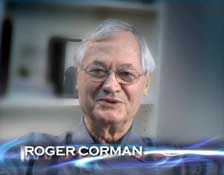 Extras
for LAST WOMAN include a energetic audio commentary with stars Carbone and Jones-Moreland,
moderated by Retromedia’s Fred Olen Ray and Steve Latshaw. The two performers
have a lot of fun stories to share about working on this no budget Corman effort,
many of which correlate to the director’s thriftiness and extreme sense
of being economical. They reveal, among other things, that the original audio
track was lost and they had to re-sync all their dialogue at a later time. Other
extras for LAST WOMAN include a few minutes of extra footage, shot several years
after the original production by Monte Hellman in order to lengthen the TV version.
Shot in black & white, the scenes reunite the three main stars (having changed
slightly in appearance) in some fluffy dialogue padding. The film’s original
color trailer is also included (most of the disc’s extras can be found
on Side A). Corman himself (hardly looking the milestone age of 80 he soon approaches)
introduces the film on camera, as he does the other two features. These are
not only nicely done to-the-point intros, but they act as sort of mini featurettes
for each film on this disc.
Extras
for LAST WOMAN include a energetic audio commentary with stars Carbone and Jones-Moreland,
moderated by Retromedia’s Fred Olen Ray and Steve Latshaw. The two performers
have a lot of fun stories to share about working on this no budget Corman effort,
many of which correlate to the director’s thriftiness and extreme sense
of being economical. They reveal, among other things, that the original audio
track was lost and they had to re-sync all their dialogue at a later time. Other
extras for LAST WOMAN include a few minutes of extra footage, shot several years
after the original production by Monte Hellman in order to lengthen the TV version.
Shot in black & white, the scenes reunite the three main stars (having changed
slightly in appearance) in some fluffy dialogue padding. The film’s original
color trailer is also included (most of the disc’s extras can be found
on Side A). Corman himself (hardly looking the milestone age of 80 he soon approaches)
introduces the film on camera, as he does the other two features. These are
not only nicely done to-the-point intros, but they act as sort of mini featurettes
for each film on this disc.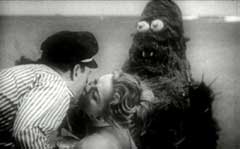
With time to spare on the Puerto Rican stay, CREATURE FROM THE HAUNTED SEA was quickly shot as the last film in this trilogy, using the main cast from LAST WOMAN. After the revolution in Cuba, American gangster Renzo Capetto (Carbone) along with his girlfriend Mary-Belle Monahan (Jones-Moreland) and his cronies help two Cuban generals and some other refugees flee the country. With a treasure chest of gold in their possession, Renzo transports the men on his boat, but has plans on killing them one by one, laying blame on a phony sea monster. Using a muddy toilet plunger to do the dirty work and generate circular foot tracks, a real underwater creature soon appears to carry out what he started.
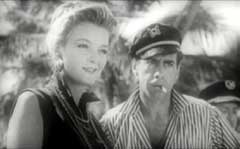 Extremely
rushed even by early Corman standards, CREATURE attempts to blend monsters with
satire, but it’s mostly a sad affair not the least bit comparable to his
earlier BUCKET OF BLOOD and LITTLE SHOP OF HORRORS. Like those films, this was
written by Charles B. Griffith (revamping his story for BEAST FROM THE HAUNTED
CAVE), and even though the premise is promising enough, it all bogs down to
irritating characters and one of the worst monsters ever to appear on screen,
which seems only to have elevated the film’s cult appeal. Supposedly the
monster was created by Corman regular Beach Dickerson, who also stars as a half-wit
who makes constant animal noises. The monster suit was built from oilskin cloth,
pipe cleaners and tennis balls, with the outcome looking like a walking turd.
Griffith wrote a complex part for Corman to play (again, to skimp on having
to pay another actor) which he gladly passed on to Bobby Beam (who also donned
the monster suit). Robert Towne (again using “Edward Wain”) appears
as a spy out to stop Renzo, and is also infatuated with Mary-Belle (with good
reason).
Extremely
rushed even by early Corman standards, CREATURE attempts to blend monsters with
satire, but it’s mostly a sad affair not the least bit comparable to his
earlier BUCKET OF BLOOD and LITTLE SHOP OF HORRORS. Like those films, this was
written by Charles B. Griffith (revamping his story for BEAST FROM THE HAUNTED
CAVE), and even though the premise is promising enough, it all bogs down to
irritating characters and one of the worst monsters ever to appear on screen,
which seems only to have elevated the film’s cult appeal. Supposedly the
monster was created by Corman regular Beach Dickerson, who also stars as a half-wit
who makes constant animal noises. The monster suit was built from oilskin cloth,
pipe cleaners and tennis balls, with the outcome looking like a walking turd.
Griffith wrote a complex part for Corman to play (again, to skimp on having
to pay another actor) which he gladly passed on to Bobby Beam (who also donned
the monster suit). Robert Towne (again using “Edward Wain”) appears
as a spy out to stop Renzo, and is also infatuated with Mary-Belle (with good
reason).
Easily the weakest
looking transfer on this set, THE CREATURE FROM THE HAUNTED SEA is presented
letterboxed at 1.85:1 (non-anamorphic). Though slightly better than some of
the previous PD offerings of this title, the black & white image is passable,
but suffers from several dark scenes, overly bright white levels, grain, lines
and other print blemishes. The mono audio is somewhat scratchy but ok.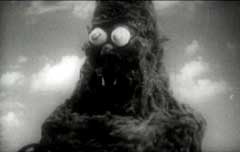
Extras for CREATURE include another commentary with Carbone and Jones-Moreland, this time moderated by Latshaw alone. The talk is on par with the one for LAST WOMAN, with more enjoyable stories concerning the cut rate film-making experience, with Latshaw amply chiming in with good questions. Scenes shot by Monte Hellman several years later for the extended TV version, are also included. They are made up of further antics of Towne’s spy character sporting a silly mustache, talking on a pay phone in the middle of nowhere, and exchanging banter with a female spy. The TV scenes also include more commotion on the ocean, with Jones-Moreland singing! The original trailer is also included.
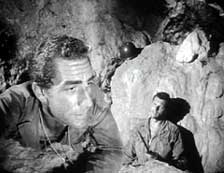 The
last film on this set, BATTLE OF BLOOD ISLAND, is the only one not directed
by Corman, but rather Joel M. Rapp who also wrote the screenplay based on a
short story Philip Roth. On the coast of a Pacific island during World War II,
gunfire between a platoon of U.S. soldiers against Japanese troops results in
a shoreline piled up with dead G.I.s. Only two of them survive: Moe (Richard
Devon) and the injured Ken (Ron Kennedy). Moe and Ron take refuge in a cave,
and knock off as many Jap soldiers as they can, until they witness the remaining
ones performing hara-kiri, signaling the end of the war. Free of an outside
threat and hoping to one day be rescued, human emotions cause tension between
the two, including several outbursts and an attempted suicide.
The
last film on this set, BATTLE OF BLOOD ISLAND, is the only one not directed
by Corman, but rather Joel M. Rapp who also wrote the screenplay based on a
short story Philip Roth. On the coast of a Pacific island during World War II,
gunfire between a platoon of U.S. soldiers against Japanese troops results in
a shoreline piled up with dead G.I.s. Only two of them survive: Moe (Richard
Devon) and the injured Ken (Ron Kennedy). Moe and Ron take refuge in a cave,
and knock off as many Jap soldiers as they can, until they witness the remaining
ones performing hara-kiri, signaling the end of the war. Free of an outside
threat and hoping to one day be rescued, human emotions cause tension between
the two, including several outbursts and an attempted suicide.
Probably the finest film in in this collection, BATTLE OF BLOOD ISLAND is void of any battle that the title and poster art may boast, but makes the most of it’s limited resources with a tight story which can be quite absorbing. Rapp’s direction is enthusiastic, with better usage of the scenic Puerto Rican locals than anything found in the other two pictures, and Devon and Kennedy are quite good, taking the roles of two strangers forced together for survival very seriously. Corman can be spotted playing an American soldier during the film’s climax.
Retromedia’s transfer of BATTLE OF BLOOD ISLAND looks pretty good. It’s presented full frame, and the black and white image is sharp and well defined for the most part, with occasional grain. Lines appear in the print source from time to time, but it’s nothing too distracting. The mono audio has limited dynamic range, but doesn’t show its age too badly.
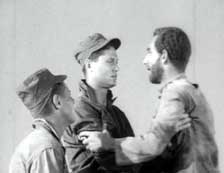 A
thorough commentary with Rapp is moderated by Fred Olen Ray. Rapp talks about
important aspects of the film, how he got the idea to adapt the story, how they
hired mainly Puerto Rican locals to play the Japanese soldiers, working with
Corman and more. He also discusses his successful run as a TV screenwriter and
his more recent undertaking as a cookbook author. Footage shot by Rapp for the
opening of the TV version is included as an extra. Shot in California, the beachside
war scenes are amusingly awkward, and the director himself looks down upon them
as being inferior from the rest of the film.
A
thorough commentary with Rapp is moderated by Fred Olen Ray. Rapp talks about
important aspects of the film, how he got the idea to adapt the story, how they
hired mainly Puerto Rican locals to play the Japanese soldiers, working with
Corman and more. He also discusses his successful run as a TV screenwriter and
his more recent undertaking as a cookbook author. Footage shot by Rapp for the
opening of the TV version is included as an extra. Shot in California, the beachside
war scenes are amusingly awkward, and the director himself looks down upon them
as being inferior from the rest of the film.
The other extras are a still gallery that showcases lobby card and poster art for all three films, as well as a Corman trailer collection which includes WAR OF THE SATELLITES, TEENAGE DOLL, ATTACK OF THE CRAB MONSTERS, IT CONQUERED THE WORLD (double billed with THE SHE-CREATURE), LITTLE SHOP OF HORRORS and more. (George R. Reis)